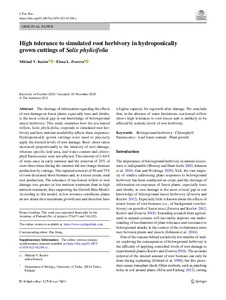High tolerance to simulated root herbivory in hydroponically grown cuttings of Salix phylicifolia
Zvereva Elena L; Kozlov Mikhail V
High tolerance to simulated root herbivory in hydroponically grown cuttings of Salix phylicifolia
Zvereva Elena L
Kozlov Mikhail V
NORTHEAST FORESTRY UNIV
Julkaisun pysyvä osoite on:
https://urn.fi/URN:NBN:fi-fe2021042825890
https://urn.fi/URN:NBN:fi-fe2021042825890
Tiivistelmä
The shortage of information regarding the effects of root damage on forest plants, especially trees and shrubs, is the most critical gap in our knowledge of belowground insect herbivory. This study examines how the tea-leaved willow, Salix phylicifolia, responds to simulated root herbivory and how nutrient availability affects these responses. Hydroponically grown cuttings were used to precisely apply the desired levels of root damage. Root: shoot ratios increased proportionally to the intensity of root damage, whereas specific leaf area, leaf water content and chlorophyll fluorescence were not affected. The removal of 2-64% of roots once in early summer and the removal of 25% of roots three times during the summer did not change biomass production by cuttings. The repeated removal of 50 and 75% of roots decreased shoot biomass and, to a lesser extent, total root production. The tolerance of tea-leaved willow to root damage was greater in low nutrient treatment than in high nutrient treatment, thus supporting the Growth Rate Model. According to this model, in low resource conditions plants do not attain their maximum growth rate and therefore have a higher capacity for regrowth after damage. We conclude that, in the absence of water limitations, tea-leaved willow shows high tolerance to root losses and is unlikely to be affected by realistic levels of root herbivory.
Kokoelmat
- Rinnakkaistallenteet [19207]
